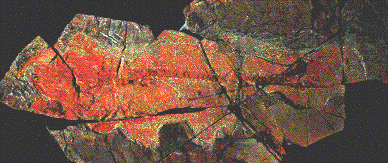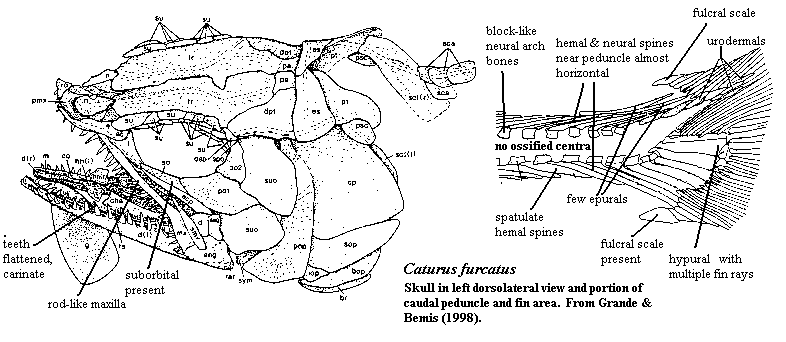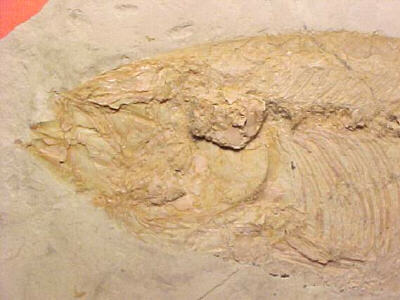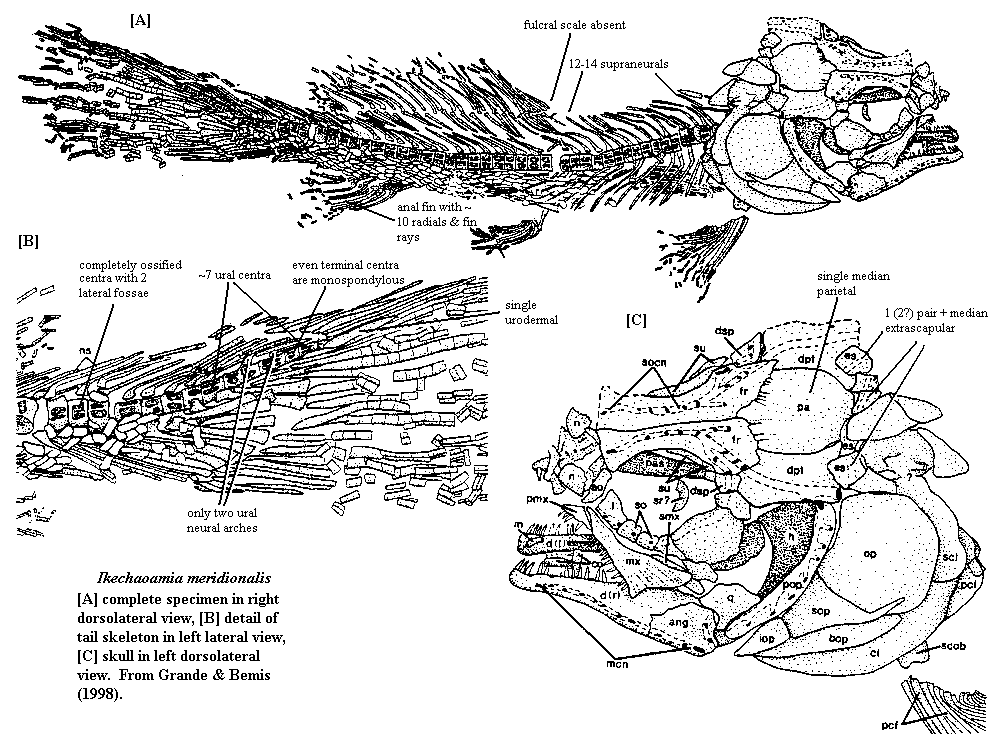 Amiiformes:
Amiiformes:| Neopterygii | ||
| The Vertebrates | Amiiformes |
| Vertebrates Home | Vertebrate | Vertebrate |
|
Abbreviated Dendrogram
Teleostomi
├─Sarcopterygii
└─Neopterygii
├─Ginglymodi
│ ├─Macrosemiiformes
│ └─Lepisosteiformes
└─Halecostomi
├─Halecomorphi
│ ├─Parasemionotidae
│ └─Amiiformes
│ ├─Caturoidea
│ └─┬─Sinamiidae
│ └─Amiidae
└─┬─┬─Semionotiformes
│ └─Pycnodontiformes
└─┬─Pachycormiformes
└─Teleostei
|
Contents
Overview |
Any discussion of Amiiformes must contend with Grande & Bemis (1998), the 500 kilogram gorilla in this part of phylospace. Like Romer & Price's (1940) review of the "pelycosaurs," and small number of equally monstrous reviews, G&B's 700+ page work will have several effects -- not all of which were intended or desirable. A study of this scope not only embodies virtually the entire corpus of knowledge about these particular corpora, but inevitably stamps the whole subject with the mold of the treatise itself, imbuing the field with an illusory sense of completeness and limiting creative input from elsewhere. Grande & Bemis try not to do this. They try hard and honestly. The tome is regularly punctuated with "this needs further work" or "further information is needed to clarify that." But, truthfully, what paleoichthyologist worth his ganoid scales wants to commit serious career-time to homework assignments handed out by G&B, however worthy of emulation these folks may be? The net result is that, like some edifice of classical and monumental architecture, the article is likely to stand alone for some time, publicly mentioned only in hushed tones of unctuous respect. Gradually, it will start to attract nit-picking academic vandalism, then anonymous graffiti, until at last the very scientific unities that informed the structure are obscured, and the work is forgotten.
This procedure normally takes a generation or two. But fortunately (or perhaps unfortunately), we ourselves are graffitores without shame or patience. So come, let us gird up our loins, take up our cans of spray paints, and deface these hallowed marble walls with a few, ill-considered words of commentary. A good graffito takes off at an angle to the baseline of its substrate, so as to clash maximally with the design it perturbs. We will proceed in this approved manner, by discussing the philosophical foundations of Grande & Bemis (1998).
The reason we care about Amiiformes -- and you would scarcely be three paragraphs deep in turgid prose from an obscure web site if you did not -- is that amiiforms are close cousins to the Teleostei, the world's most successful and diverse order of vertebrates. Even had we other motives, the looming presence of the teleosts, like the presence of Grande & Bemis (1998) itself, would be difficult to ignore. As a result, the questions we might want to address are things like: where and how did the amiiforms diverge from the teleosts? In what ways did they develop convergently? Why is A. calva, and only A. calva, able to survive in a world dominated by teleosts?
Unfortunately, we learn almost nothing about these matters. After 700 pages of "empirical" data-gathering, Grande & Bemis are willing, at most, to talk a little about patterns of geographical distribution over time. Not, mind you, that they are willing to actually draw any conclusions. They simply point out the relationship of the Amiiformes to the state of the Tethys Seaway over time. Indeed, G&B seem to go out of their way to avoid actually using all this information for any purpose.
Grande & Bemis may be infected with a loathsome philosophical disorder which we may call Geeism, after Henry Gee, a sometimes cantankerous editor of Nature and the author of In Search of Deep Time. Gee argues that the whys and wherefores of evolution, as well as the actual modes of life and ecological relationships of ancient ecosystems, are essentially unknowable. On the scale of deep time, or within the scope of a system as complex as a planetary ecosystem, it is not even theoretically possible to determine cause and effect. Thus, all we can do is to describe those few, random features of the past which are accessible to us by accidents of preservation. We cannot know the true nature of the past in deep time, and any attempt to discuss mechanism, beyond description, is inherently futile.
Like a lot of soi-disant deep philosophical thinking in scientific circles, this is crap. I do not mean to say that there is anything wrong with Gee's premise, his logic or his conclusion. I mean that it is completely and utterly the wrong question. Geeism assumes a watchmaker's universe, one in which the role of the scientist is to reveal, in ever finer detail, the causal links of unique causes to unique effects from the featureless singularity of Time = 0 to the equally featureless heat death of infinite future time. But this is not our universe. The universe, as we currently know it, is full of inherent uncertainties, quantum randomness and foamy, non-linear spacetime. Oddly enough, this has not reduced physics to the "empirical" description of individual quanta over limited trajectories. That would be both futile and pointless, as is Grande & Bemis's crabbed version of paleontology. Fortunately the physics community has been able to move beyond the Nineteenth Century philosophical framework which appears to constrain many paleontologists.
The key, oddly enough, is empiricism. This is a concept which Grande & Bemis frequently invoke, but obviously do not understand. The emphasis in empiricism is not on the mindless accumulation of observational data. It is on figuring out what works. We can say nothing much useful about "cause" and "effect." That's true. But, can we make statistical statements about a broad range of similar events? Can we, perhaps, analyze the irreducibly complex -- not in terms of cause and effect -- but as a small number of much simpler mechanisms, as argued by Wolfram 2002)? Can we identify repeated homoplasies, long-term trends, and patterns of speciation which suggest that some selective forces are operating over a background of essentially random events?
Of course we can. These sorts of statements are not formulations of the "causes" of evolutionary events. Perhaps such empirical statements are only descriptions at a more abstract level. However, it is certainly possible to do more than stamp collecting; and, to the true empiricist, the distinction between a "cause" and a "description" is at most a matter of degree. The point is, does it work? Is it useful? If it meets those criteria, we can let the Kantians and that sort worry about whether it's a "cause." As scientists and empiricists we will have done our job.
Because Grande & Bemis refuse to go beyond elementary personal observation, we have to question whether they have done theirs. It may be too early. These same authors have comprehensively reviewed the Chondrostei. Grande & Bemis 1996). They are apparently working on the Lepisosteiformes. Clearly, there is a pattern here. Sooner or later, one hopes, they will be moved to tell us what the pattern is.
And so, having overlaid ten years' hard labor by two very able scientists with a fluorescent splash of color born of a fifteen minute temper tantrum, we may move on. Our work here is done. APW 040806.
Range: from the Early Triassic, cosmopolitan. Currently restricted to fresh waters of North America.
Phylogeny: Halecomorphi:: Ionoscopiformes + *. Caturoidea + (Sinamiidae + Amiidae).
Characters: Amia with a thin layer of bone covering largely cartilaginous skeleton; dermosphenotic sutured into & forming part of skull roof [GB98]; dermosphenotic sutured into & forming part of skull roof [GB98]; sclerotic ring present as two half-rings [GB98]; preoperculum crescentic, long & narrow [GB98]; $ opisthotic absent [GB98]; $ pterotic absent [GB98]; large median gular plate and 10-13 branchiostegal rays; vertebrae amphicoelous; primitively, parapophyses not fused to abdominal centra [GB98]; dorsal fin base long, with about 48 rays; caudal fin short & heterocercal; caudal fin "almost homocercal"; $? <3 ossified ural neural arches [GB98]; cycloid scales; swim bladder can function as a lung; vestigial spiral valve intestine.
Image: Nipponamia satoi from the Early Cretaceous of Japan. See Early Cretaceous Freshwater fish fauna in Kyushu, Japan.
Links: Amiiformes after Grande & Bemis, 1998; Orders Summary; temp; Osteichthyes Continued; Systematics of major fish groups V; The Order Amiiformes; Otryad amneobrazhnye (Russian).
References: Grande & Bemis (1998) [GB98]. APW 040806.
 Caturoidea: Amblysemius, Caturus, Liodesmus
Caturoidea: Amblysemius, Caturus, Liodesmus
Range: Early Jurassic of Europe
Phylogeny: Amiiformes: (Sinamiidae + Amiidae) + *.
Characters: $ slender, rod-like maxilla [GB98]; sclerotic ring present [GB98]; 1-2 suborbitals present [GB98]; $ many (22+) branchiostegal rays [GB98]; $ flattened, sharply carinate teeth [GB98]; vertebrae without ossified centra [GB98]; $ paired, block-like neural arch ossifications [GB98]; $ hemal spines broadly spatulate in transverse plane [GB98]; some diplospondyly (but without fully ossified centra -- alternating ventral and dorsal hemicentra) [GB98]; parapophyses not fused to abdominal centra [GB98]; fin fulcra present [GB98]; anal fin with 11-13 proximal radials and 14-16 segmented radials [GB98]; caudal fin forked [GB98]; numerous ural neural arches [GB98]; $ preural hemal & neural spines in region of caudal peduncle strongly inclined to a near horizontal orientation [GB98]; several >2?) urodermals in adults [GB98]; "only a few" epurals [GB98]; some hypurals bearing many fin rays [GB98]; numerous supraneurals [GB98].
Images: Caturus furcatus (type) from the Muséum d'Histoire Naturelle Neuchâtel. Photo by Joël von Allmen
Links: Caturus sp.; CATURUS; p2 - caturus.jpg; caturus; Verkaufs- und Tauschliste.; Solnhofen-Fishes.page; Halecomorpha; Weigert-Fossil - Fish of Prey; MHNN - Collections géologiques type specimen); Fossilien aus dem Plattenkalk von Solnhofen und Eichstätt ( ....
References: Grande & Bemis (1998) [GB98]. APW 040806.

 Sinamiidae: Ikechaoamia, Sinamia.
Sinamiidae: Ikechaoamia, Sinamia.
Range: Early Cretaceous of China & Japan?
Phylogeny: Amiiformes:: Amiidae + *.
Characters: $ dermopterotics short, about same length as parietal [GB98]; $ single median "parietal" [GB98]; extrascapulars present as 1 pair plus 1 median extrascapular [GB98]; centra with variable number of lateral fossae, usually 2 [GB98]; abdominal and preural caudal centra completely ossified perichordally [GB98]; diplospondyly absent [GB98]; parapophyses not fused to abdominal centra [GB98]; number of supraneurals low 5-14) [GB98]; fin fulcra absent [GB98]; anal fin with ~10 proximal radials [GB98]; anal fin with 8-11 fin rays [GB98]; caudal fin with convex, rounded margin [GB98]; ~7 ural centra [GB98]; 1-3 ural neural arches [GB98]; "only a few" epurals [GB98]; urodermals two or fewer [GB98]; approximately 1:1 ratio of caudal fin rays to hypurals [GB98]; ganoid scales present [GB98].
Image: Sinamia from Pangaea Fossils.
Links: Evaluation of knowledge of advanced actinopterygians at the ...; Tomognathus an unusual Chalk fish; ... (Chinese); ?????? Chinese).
References: Grande & Bemis (1998) [GB98]. APW 040806.

checked APW 040806.